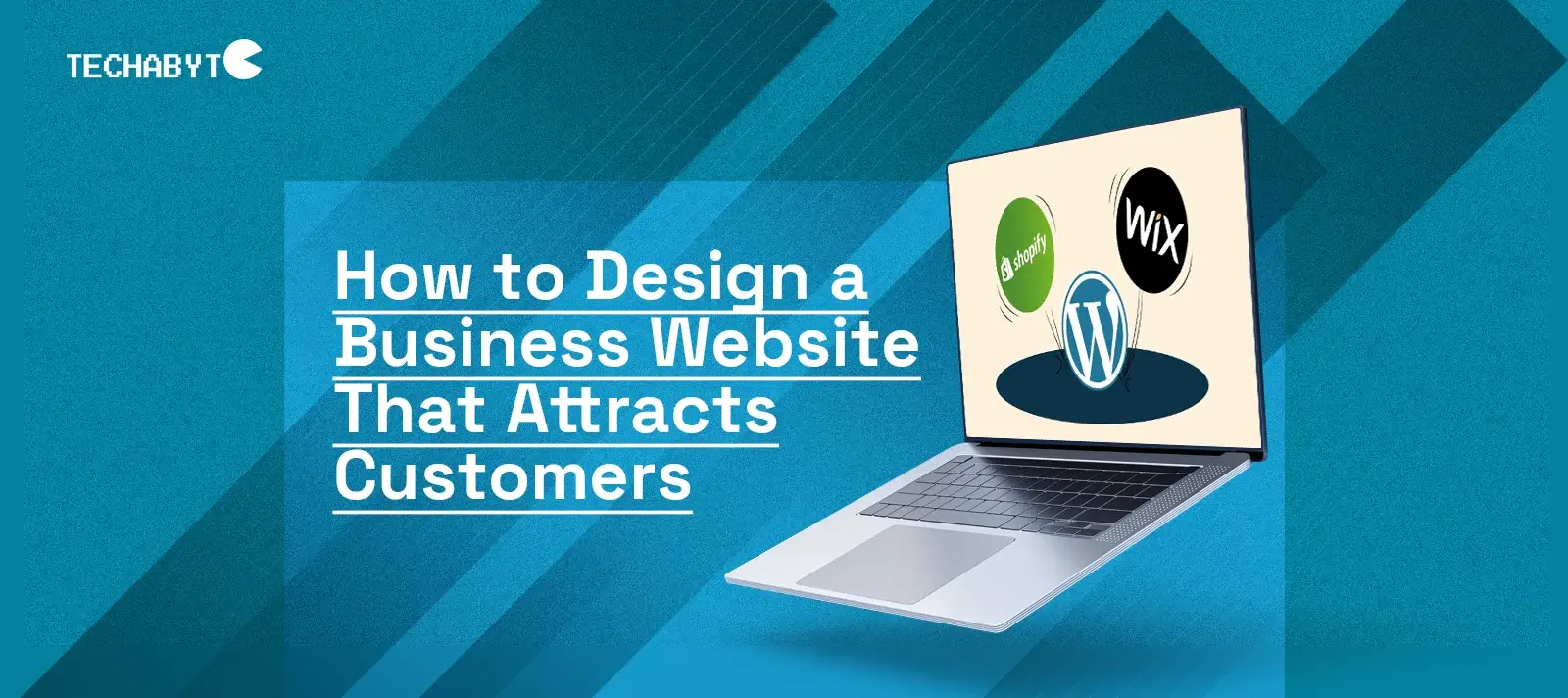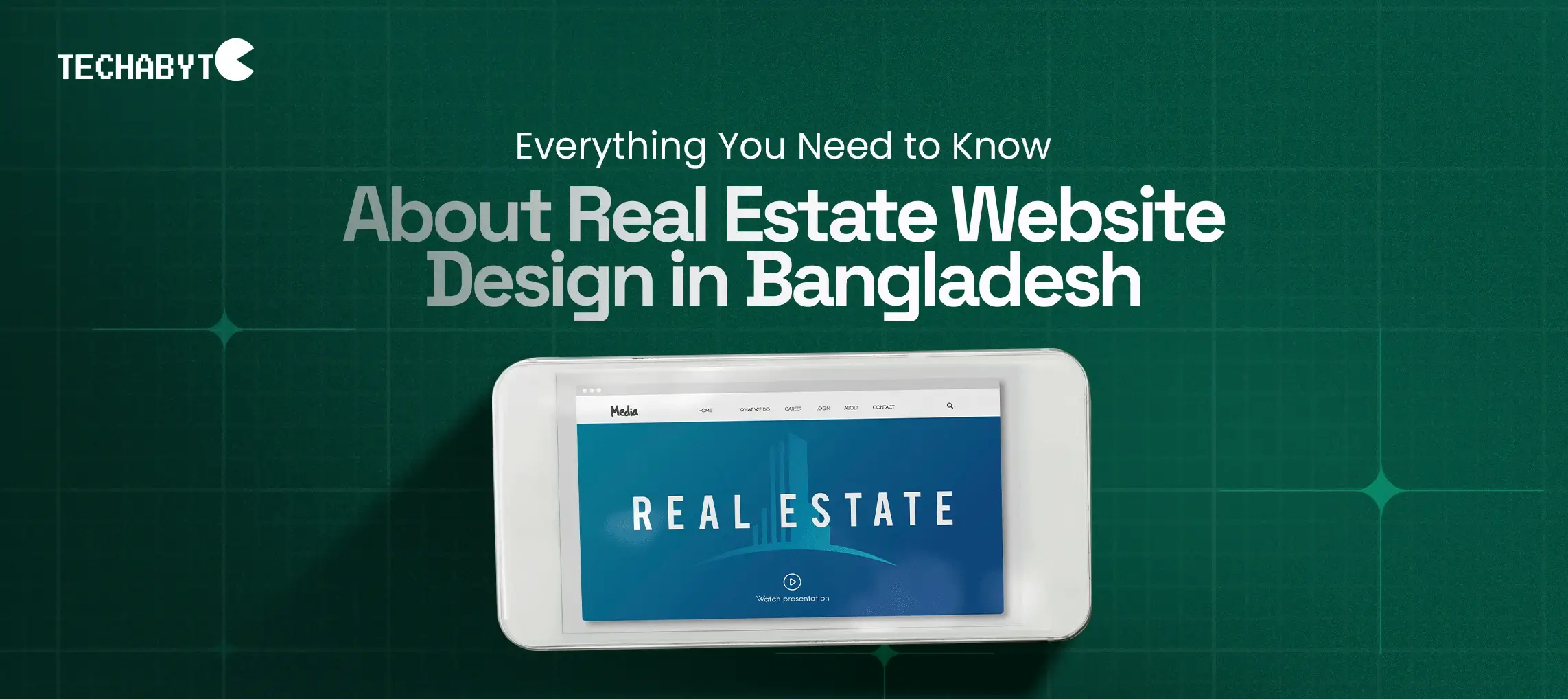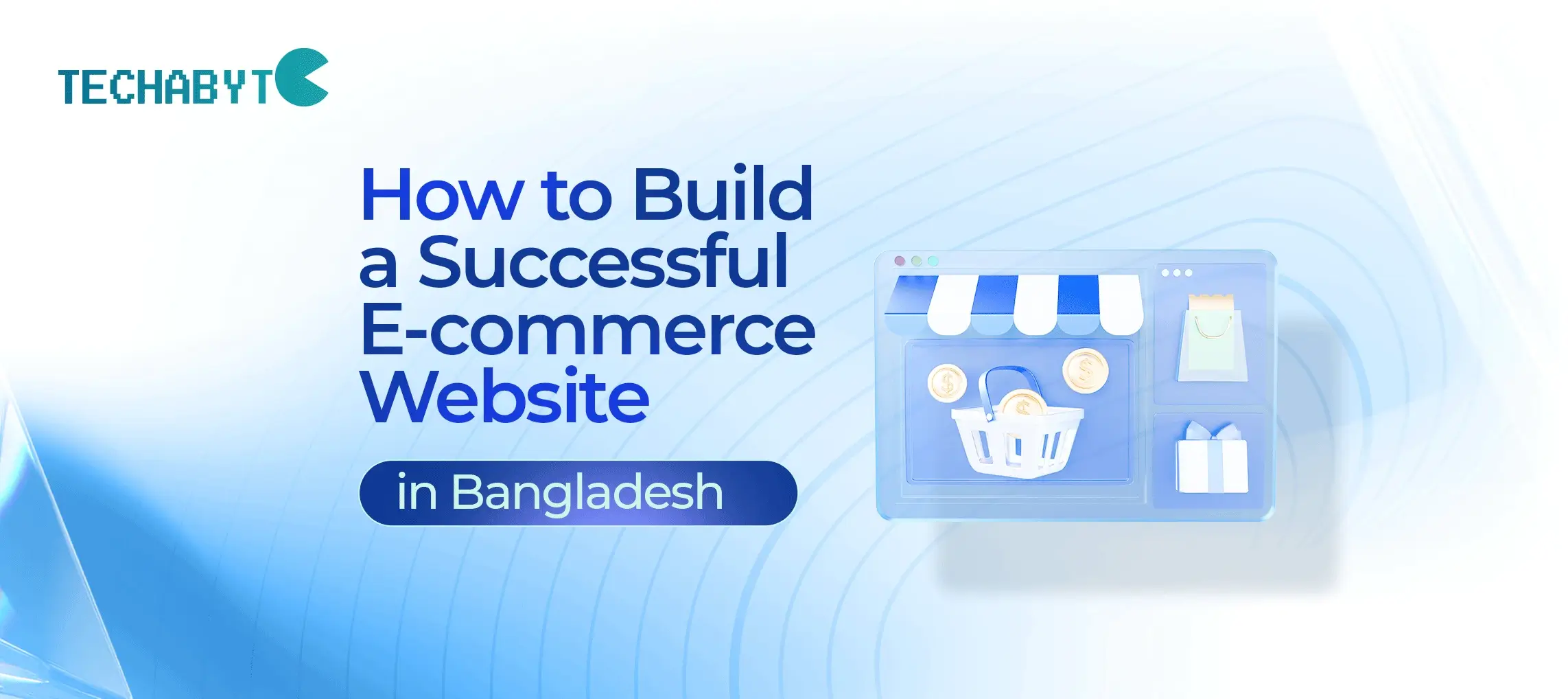A business website requires careful planning, intelligent design, and continuous optimization for its success. An overview of this guide includes the setting of clear objectives, choosing the right platform, professional layout design, high-quality content creation, and feature integration to mobile-, UX-, and SEO-optimization. Among others, higher-level considerations include AI integration, voice search, future-proof design, and analytics tracking. It will definitely attract visitors and engage them appropriately to convert by testing properly, getting ready for launching with adequate preparation as well as continuously improving it.
Techabyte Solutions also provides professional web design and development services for businesses desiring expert consultancy in building ultra-modern high-performing websites fitting their brands and business goals.
Key Takeaways
- Plan & Define Goals: Define the purpose, audience, and features of the site before its design.
- Mobile & UX First: Implement responsive designs with fast loading times and easy navigation plus accessible user interfaces.
- High-Quality Content: Develop attractive pages using visuals and multimedia content accompanied by sections that readily address questions.
- Essential Features & SEO: Include contact forms, chat, FAQs, blogs, and optimize for search engines.
- Future-Proof & AI Ready: Use modular, clean design for AI integration, voice search, and automation.
- Test, Launch & Maintain: Check performance, fix issues, and continuously improve based on analytics.
- Partner with Experts: Companies such as Techabyte Solutions build websites that fit your business needs. These sites are scalable and high-performing.
Set Clear Goals for Your Business Website
Before you begin designing anything, write down what you expect your website to do for you. A website with no defined goals is always confusing, unfocused, and does not convert visitors into customers. The proper setting of goals helps in guiding the layout, content, features, and overall user experience.
Define the Primary Purpose of Your Website
Each business website should have a single core purpose. Knowing this up front will direct every design decision you make.
Most common primary goals are:
✔ Sales
If your website is more product or service oriented, you need to concentrate on:
- Clean product/service pages
- Strong CTAs (“Buy Now”, “Book a Service”)
- Mobile friendly checkout
- Trust elements like reviews and guarantees
✔ Lead Generation
If your goal is lead collection then the design:
Should have visible contact forms
- Lead magnets – free consultations, quotes, ebooks
- Strong CTA placement
- Minimum distractions
- Simple user flow – Home -> Service -> Contact
✔ Branding & Credibility
If your goal is authority and trust:
- Quality visuals; professional design
- About page telling your story
- Testimonials, case studies
- Brand colors, typography are consistent
- Thought leadership content (blogs, guides) has been published regularly in recent months/years/ etc.
✔ Information / Educational
If your site’s goal is to inform:
- clean design
- Organized navigation
- Collections of resources or just blog sections
- FAQ pages
- Clear categorization
Identify Your Target Audience & User Intent
Good design starts with knowing who you’re designing for.
Ask yourself:
- Who will visit the site?
- What problems are they trying to solve?
- What questions do they have that they want to get a quick answer to?
- What do you want them to do (i.e. buy, call, book, sign up)?
Understand User Intent
Visitors come with different intents:
- Informational intent: To learn something → Blog should be given utmost priority, FAQs, guides
- Commercial intent: Feature comparisons, reviews, trust badges
- Transactional intent: Fast checkout, CTAs, clear pricing visibility
- Navigational intent: They want specific pages → Clear menu, breadcrumbs, internal search
By understanding user behavior, you can:
- Choose the right layout
- Place CTAs where users naturally look
- Create content that answers user questions
- Reduce friction in the buying process
Example:
A local service website should show phone number, WhatsApp, service area, and pricing clearly because users want quick answers.
Decide on Must-Have Website Features
Your website’s features should support your primary goal and serve your audience’s needs.
Here are essential features to consider based on different business types:
✔ For Service Businesses
- Contact forms
- Appointment or booking system
- Pricing table
- Portfolio or case studies
- Testimonials and reviews
- Live chat or WhatsApp button
✔ For Ecommerce Websites
- Product catalog
- Cart & checkout
- Wishlist
- Payment gateway integration
- Customer account area
- Order tracking
- Shipping calculator
✔ For Personal Brands or Professionals
- About page
- Portfolio or work samples
- Blog or articles
- Contact form
- Integration with social channels
✔ For Local Businesses
- Google Map integration
- Click-to-call button
- Operating hours
- Local landing pages
- Reviews and ratings
✔ Universal Must-Have Features
- Mobile-responsive design
- Fast loading speed
- SSL security
- Clear navigation
- Search bar
- Accessibility features
Choose the Right Platform or CMS
While adopting such basics of website design as learning approach and selection of the appropriate platform/ CMS the latter defines the flexibility, speed, design opportunities, security, scalability, and further costs of business operation associated with website maintenance.
Here’s what the distribution of the most popular platforms looks like: How to Choose the Right One for Your Business
WordPress (Best Overall Choice for Most Business Websites)

WordPress runs 40% of the internet for good reason. It is the most flexible platform for businesses of any size and extremely SEO friendly.
Why Choose WordPress
- Why You Should Be Using WordPress
- Total flexibility with Themes + Page builders (Elementor, Gutenberg, Divi)
- Best in SEO (Clean code, plugin choices, full control)
- Grows with you from a small business to a big company
- Саn be integrated with marketing tools (CRM, emаil аutоmаtiоn, live chat)
Best For:
- Service businesses
- Agencies
- Corporate websites
- Local businesses
- Blogs
- Personal brands
- Portfolio sites
Possible Downsides
- Requires some technical knowledge
- Must manage hosting, security, and updates
If you want maximum flexibility, WordPress is the best foundation when designing a business website.
Shopify (Best Platform for Ecommerce Businesses)

Shopify – the platform is the first in terms of online product sales. If your business website has primarily been set up for this purpose, then Shopify is by far the most hassle-free and trusty solution.
Why Choose Shopify
- Smooth and secure checkout
- Built-in payment gateway
- Fast, reliable hosting
- Inventory management
- Professional product pages
- Apps for upsells, reviews, shipping tools
Best For:
- Ecommerce stores
- D2C brands
- Clothing, cosmetics, gadgets, food products
- Any business selling physical or digital items
Possible Downsides
- Monthly subscription cost
- Limited design flexibility compared to WordPress
- Apps can become expensive
If selling online is your top priority, Shopify is the perfect choice.
Wix / Squarespace (Best for Beginners & Small Businesses)

These drag-and-drop builders are perfect for beginners who want to design a simple business website quickly without technical skills.
Why Choose Wix / Squarespace
- Extremely easy to use
- No coding required
- Beautiful pre-designed templates
- Hosted platform (no technical setup needed)
- Good for small, simple websites
Best For:
- Small businesses
- Freelancers
- Restaurants
- Personal brands
- Single-service websites
- Basic portfolios
Possible Downsides
- Not very scalable
- Limited SEO control
- Lower flexibility than WordPress
- Migration to another platform is difficult
If you want simplicity and fast launch, these platforms are great choices.
Custom-Built Websites (For Enterprise & Unique Requirements)
A custom-built website is designed from scratch using coding languages like HTML, CSS, JavaScript, PHP, or frameworks like Laravel, React, Next.js, etc.
Why Choose a Custom Website
- Complete design freedom
- Tailored features that CMS platforms cannot provide
- Better performance if developed properly
- No reliance on plugins
Best For:
- Large companies
- Unique business models
- High-security websites
- Enterprise-level applications
- Digital platforms requiring custom dashboards
Possible Downsides
- Very expensive
- Longer development time
- Requires a dedicated development team
- More complicated to maintain
Choose this option only if you need features that common CMS cannot provide.
How to Pick the Right Platform Based on Your Business Needs & Budget
Here’s a quick guide to help you choose the best platform when deciding how to design a business website:
Choose WordPress if:
- You want the best balance of cost, control, customization, and SEO
- You run a service business, agency, corporate site, blog, or local business
- Your budget is low–medium
- You want long-term scalability
Choose Shopify if:
- Your main goal is selling products
- You want a secure, smooth checkout
- You prefer a platform that handles hosting and security automatically
Choose Wix/Squarespace if:
- You want a simple, easy, and beginner-friendly setup
- You have a small business and limited technical skills
- You want quick launch at low cost
Choose Custom Development if:
- You need advanced features not possible with popular CMS
- You have a high budget
- You want full design freedom
- You plan to build a large platform or enterprise solution
Pro Tip for Beginners
If you’re not sure which platform to choose, start with WordPress.
It offers the best mix of:
- Cost efficiency
- SEO advantage
- Design flexibility
- Easy future growth
Plan Your Website Structure
Plan out how your entire website is going to be organized before writing a single line of code. A clear structure facilitates easy browsing for users and helps search engines comprehend your pages. This is an important step in learning how to design a business website successfully.
Create a Sitemap That Fits Your Business
Your sitemap acts as the blueprint of your website. It lays out the main pages and their connections.
Common pages for a business website include:
- Home
- About
- Services / Solutions
- Products (if applicable)
- Portfolio / Case Studies
- Blog / Resources
- Contact
A well-planned sitemap ensures visitors can find information quickly — a core part of designing a high-converting business website.
Build Logical Navigation
Your navigation menu should be simple, intuitive, and predictable.
Best practices:
- Keep top-level items between 5–7.
- Use short, clear labels (e.g., “Services”, not “What We Offer”).
- Ensure important pages are reachable within 2 clicks from the homepage.
Logical navigation enhances user experience and raises conversions — key when learning how to build a business site that works right
Create a User-Friendly Site Hierarchy
Search engines and users both rely on a clean hierarchy.
Ideal structure:
- Level 1: Homepage
- Level 2: Main categories (Services, About, Blog)
- Level 3: Detailed pages (Service subpages, blog posts, product pages)
This creates a predictable browsing path and avoids confusion, especially for first-time visitors.
Ensure Crawlability & SEO-Friendly Structure
Your structure also impacts SEO performance.
SEO structure tips:
- Use clean URLs (/services/website-design/ instead of /service?id=123)
- Add internal links between related pages
- Organize blogs with categories and tags
- Avoid orphan pages (every page should link from somewhere)
- Submit sitemap.xml to Google Search Console
A well-structured site helps Google crawl and index your pages faster — an essential part of how to design a business website for SEO success.
Design a Professional & Brand-Focused Layout
A neat, unified, and brand-related design does not only look good but also helps users to do useful things.
Choose the Right Website Template or Theme
Choosing a template or theme puts the base for your website’s look and work.
Tips for choosing a template:
- Opt for a clean and modern design
- Ensure it’s mobile-responsive and works across devices
- Pick a theme that is compatible with your chosen platform (WordPress, Shopify, Wix, etc.)
- Avoid cluttered layouts or outdated styles
- Choose templates optimized for speed and usability
A thoughtful choice here makes building and customizing the rest of the website easier.
Maintain Consistent Brand Colors, Typography & Visuals
Consistency reinforces brand identity and creates a cohesive experience for visitors.
Best practices:
- Use a limited color palette (2–3 main colors)
- Stick to 1–2 fonts for headings and body text
- Keep button styles, icons, and graphics uniform
- Use images and illustrations that reflect your brand personality
- Ensure copy and visual tone align with your overall brand message
Consistency helps visitors recognize your brand and builds trust immediately.
Keep a Clean Layout & Use Whitespace
Whitespace (empty space) improves readability and draws attention to key content.
Tips for clean layout:
- Avoid overcrowding sections with too much information
- Break content into short paragraphs and bullet points
- Organize sections using grids or cards
- Highlight important elements with spacing and contrast
- Focus on simplicity and clarity
A balanced layout ensures visitors can navigate the site without feeling overwhelmed.
Above-the-Fold Design Best Practices
The top section of a webpage, visible without scrolling, is critical for engagement.
What to include above the fold:
- A clear, concise headline that conveys your value
- A supportive subheadline or tagline
- A prominent call-to-action button
- A relevant hero image, video, or illustration
- Trust indicators such as client logos, awards, or testimonials
A strong first impression encourages users to explore further and interact with your content.
Create High-Quality Content for Each Page
Content, of course, is king. Informational content services the visitor but also that service provider’s credibility and expertise and encourages engagement. Every page plays a part in helping users progress through the site.
Engaging Homepage Copy
The homepage is often used as introduction: The homepage serves as the introductory handshake and immediately communicates values.
Tips for homepage content:
- Use a clear, concise headline that explains what you offer
- Taglines punch up the value propositions if possible
- List Out Your Most Important Products and/ or Services
- Use Really Compelling Calls to Action like ‘‘Start Today’’ and ‘‘Call Now to Schedule Your Free Consultation’’
- A well-crafted homepage will lead visitors to continue exploring other pages
Service / Product Page Writing Tips
Service or product pages are typically the bottom of the funnel; it’s here a prospect will decide whether to engage with your business.
Best practices:
- Be clear about it and its benefits.
- Highlight the main benefits rather than just features
- Pricing or packages, where applicable.
- Supporting visuals like images, icons, infographics, etc.
- Include calls-to-action such as “Request a Quote” or “Buy Now”
Good service/product pages reduce friction and help visitors take action.
About Page That Builds Trust
The About page tells your story and establishes credibility.
What to include:
- Company history and mission
- Team introduction and expertise
- Values and vision
- Awards, certifications, or notable clients
- Personal touches that humanize the brand
An authentic About page reassures visitors that your business is reliable and professional.
Contact Page Essentials
The Contact page makes it easy for visitors to reach you. Make communication simple and accessible.
Key elements:
- Contact form with minimal required fields
- Phone number, email address, and physical location
- Click-to-call buttons for mobile users
- Embedded Google Map if you have a physical location
- Optional social media links
A clear, easy-to-use Contact page improves conversions and encourages inquiries.
Importance of Visuals and Multimedia
Images, videos, and graphics enhance understanding and engagement. They break up text and make your website visually appealing.
Tips for visuals:
- Use high-quality, relevant images
- Incorporate product photos or service demonstrations
- Include videos for storytelling or tutorials
- Add infographics to explain complex information
- Maintain a consistent style to align with your brand
Visuals make content more engaging and help visitors remember your message.
Optimize Your Website for Mobile Devices
Therefore, since the majority of users view from smartphones and tablets, it is necessary to make sure that your website is working fine on mobile devices. Better mobile usability further improves user engagement, conversions, and even search rankings.
Follow Responsive Design Principles
Responsive design ensures your website adapts to any screen size automatically. Key points include:
- Flexible grids and layouts that adjust to different devices
- Images that resize without distortion
- Text that remains readable on small screens
- Consistent branding across desktop, tablet, and mobile
A responsive site creates a smooth experience for every visitor.
Implement a Mobile-First Layout
Designing for mobile first ensures the most important content is visible and easily accessible.
- Prioritize key elements like headlines, CTAs, and contact info
- Keep navigation simple and concise
- Remove unnecessary clutter that slows down mobile browsing
Mobile-first design forces you to focus on what really matters for users.
Make Buttons and Navigation Touch-Friendly
Interacting on a touchscreen is different from using a mouse. Small design adjustments can drastically improve usability.
- Make buttons large enough for easy tapping
- Ensure spacing between links to prevent accidental clicks
- Keep menus simple or use collapsible menus for small screens
- Place CTAs where thumbs naturally reach
A touch-friendly interface encourages users to interact with your website instead of leaving it.
Understand Why Mobile UX Affects Ranking & Conversions
Google prioritizes mobile-friendly websites in search results, and visitors are more likely to leave if a site is difficult to use on mobile.
- Faster mobile load times improve SEO and reduce bounce rates
- Easy navigation increases conversions and engagement
- Clear calls-to-action on mobile drive leads and sales
Optimizing for mobile is no longer optional — it’s a requirement for a successful website.
Focus on User Experience (UX) and User Interface (UI)
A visually appealing site matters, but good looks also have to give a great time. Putting UX and UI first makes sure people can move around your place with ease, get what they need to know, and do what they want without any trouble.
Ensure Fast Load Times
Slow-loading websites frustrate users and increase bounce rates. To improve speed:
- Optimize images and videos for web
- Minimize use of heavy scripts or plugins
- Use caching and fast hosting solutions
- Test website speed regularly using tools like Google PageSpeed Insights
Fast-loading pages improve engagement, conversions, and even search engine rankings.
Make Navigation Easy
Clear and intuitive navigation keeps visitors on your site longer.
- Use a simple, logical menu structure
- Include breadcrumbs for multi-level pages
- Group related pages under clear categories
- Keep menus consistent across all pages
Visitors should always know where they are and how to find what they need.
Create Clear Calls-to-Action (CTAs)
CTAs guide visitors toward important actions, such as contacting you or making a purchase.
- Use contrasting colors for CTA buttons
- Keep the language concise and action-oriented (“Get a Quote,” “Book Now”)
- Place CTAs strategically throughout the site
- Limit distractions around CTA areas
Well-designed CTAs improve conversions and help achieve your business goals.
Maintain a Minimalistic, Frustration-Free User Flow
Cluttered layouts or complicated workflows can confuse users.
- Simplify forms and reduce unnecessary steps
- Break content into digestible sections
- Highlight the most important actions first
- Remove pop-ups or intrusive elements that disrupt browsing
A smooth, frustration-free flow keeps users engaged and satisfied.
Follow Accessibility Guidelines (WCAG)
Web accessibility ensures your website is usable by everyone, including people with disabilities.
- Use readable fonts and proper contrast
- Add alt text for images
- Make your site navigable by keyboard
- Ensure forms and media are accessible
Accessible design not only broadens your audience but also improves overall usability and credibility.
Add Essential Business Website Features
Add those features which will make your website fulfill the requirements of your visitors and, at the same time, helps you to achieve your business goals. The features mentioned below are imperative for contemporary business sites. Put in those attributes which will ensure that your site caters to the needs of its users as well as assists you in accomplishing your organizational objectives. The aspects described beneath are crucial for present-day corporate web pages.
Contact Form
A simple and accessible contact form allows visitors to get in touch quickly.
- Keep fields minimal to encourage submissions
- Include required information like name, email, and message
- Add a confirmation message to reassure users their message was sent
A well-designed contact form increases inquiries and leads.
Live Chat
Live chat provides instant support and improves engagement.
- Offer real-time assistance for questions or concerns
- Use chatbots to handle common queries automatically
- Make the chat button visible but non-intrusive
Live chat can boost conversions by helping visitors make faster decisions.
Booking System
If you provide services, a booking or appointment system simplifies scheduling.
- Allow users to select time slots and services
- Send automated confirmations and reminders
- Sync with calendars for easy management
A smooth booking experience enhances customer satisfaction and reduces administrative work.
Testimonials & Reviews
Social proof builds trust and credibility.
- Showcase client testimonials prominently on service pages or homepage
- Include star ratings or client logos
- Use real names and photos when possible for authenticity
Positive reviews help potential customers feel confident in choosing your business.
Portfolio or Case Studies
Demonstrating your past work or results establishes expertise.
- Include images, descriptions, and outcomes
- Highlight diverse projects or client successes
- Organize by category for easy browsing
Portfolios and case studies strengthen your authority and influence purchasing decisions.
FAQ Section
FAQs address common questions and reduce barriers to engagement.
- List frequently asked questions clearly
- Provide concise, helpful answers
- Update regularly as new questions arise
A well-structured FAQ improves user experience and reduces support workload.
Blog for SEO & Authority
A blog adds educational value, builds credibility, and drives organic traffic.
- Focus on topics your audience searches for
- Organize posts by categories for easier navigation
- Include visuals, examples, and actionable tips
- Update regularly to keep content fresh
A blog enhances your website’s authority and supports long-term growth.
Designing for Faster Core Web Vitals
For user experience and search rankings, website speed and performance are considered very important. Core Web Vitals optimization makes sure that the site is fast-loading, seamless in running, and maintaining visitors.
Use Next-Gen Image Formats
Images are often the largest files on a page. Using modern formats can significantly reduce load times:
- Use WebP or AVIF instead of JPEG/PNG
- Compress images without losing quality
- Serve appropriately sized images for different devices
Faster-loading visuals improve overall page performance and user satisfaction.
Avoid Heavy Scripts
Excessive or unoptimized scripts can slow down your site.
- Minimize the use of unnecessary plugins
- Defer non-critical JavaScript
- Combine or minify scripts where possible
Reducing script load keeps pages responsive and smooth.
Use Modular Design for Speed
Modular design organizes your website into reusable, lightweight components.
- Break pages into sections (header, hero, content blocks, footer)
- Reuse components across multiple pages
- Reduce redundant code and assets
This approach improves maintainability and speeds up page rendering.
Implement Mobile Speed Hacks
Mobile users are especially sensitive to slow pages. Boost performance using these techniques:
- Lazy loading for images and videos to load content as users scroll
- Inline critical CSS to display above-the-fold content faster
- Minimize heavy fonts and external requests
- Prioritize visible content for quick rendering
Optimizing mobile performance enhances user experience and helps maintain high engagement across devices.
Integration of Chatbots, AI Assistants & Automation
State-of-the-art sites progressively utilize AI and automation for better user involvement, offering immediate help as well as smoothing out business activities. Appropriately adding these apparatuses can improve the guest experience and drive transformations.
How Modern Business Websites Use AI Chatbots
AI chatbots provide instant responses to common questions, guide users through services, and collect leads. Key benefits include:
- Answering repetitive queries 24/7
- Directing users to relevant pages or resources
- Collecting user information for follow-up
- Reducing the need for live support staff
Using chatbots effectively improves responsiveness and user satisfaction.
Design Placement for Maximum Conversions
The placement of chatbots affects usability and engagement:
- Position in the bottom-right corner for visibility without being intrusive
- Trigger proactively on key pages, such as pricing, services, or contact
- Use clear introductory messages to guide users
Strategically placed chatbots can increase interactions, lead capture, and overall conversions.
AI-Driven FAQ Sections
AI can enhance FAQ sections by:
- Automatically suggesting answers based on user queries
- Personalizing responses based on previous interactions
- Highlighting relevant content or products dynamically
An AI-driven FAQ improves user experience, reduces friction, and ensures visitors find answers quickly.
Designing for Voice Search Users
Because voice assistants like Siri, Google Assistant, and Alexa have become popular, optimizing for voice search has also become important. In the design perspective, content perspective, and user interaction perspective, voice search requires a different approach.
Voice-Search-Friendly UI
Voice users expect quick, concise answers. Your website should:
- Use clear headings and structured content
- Highlight key information in short paragraphs or bullet points
- Implement schema markup (FAQ, HowTo, Q&A) to make content easily interpretable by voice assistants
A voice-search-friendly UI ensures your site can provide accurate responses when users speak their queries.
Quick-Action Buttons for Mobile & Voice Users
Voice search is often used on mobile devices, so your website should include:
- Click-to-call buttons for instant calls
- Quick navigation buttons for appointments or services
- Easy-to-access contact forms or chat options
These features make it easy for visitors to act immediately after performing a voice search.
How Siri and Google Assistant Interpret Website Structure
Voice assistants rely on well-organized content and structured data to deliver accurate answers.
- Use proper headings (H1, H2, H3) to outline sections
- Implement schema markup for FAQs, products, and services
- Maintain clear and concise page content
- Ensure fast loading speed and mobile-friendliness
Optimizing your website structure for voice search helps your content be discoverable and actionable through voice commands.
Preparing Design for Future AI & Automation Tools
As AI and automation grow, having future integration in the mind of your website makes it easy to keep it flexible, scalable, and competitive. Plan ahead so that you can take on new tools without having to redo everything.
Design for Easy Integration with Future Plugins
Modern websites benefit from modular architecture that can accommodate AI assistants, automation tools, or analytics plugins.
- Use widely supported CMS platforms like WordPress or Shopify
- Ensure your codebase follows best practices and is clean
- Leave room for new sections, widgets, or features
This approach allows seamless integration of emerging tools as your business grows.
Avoid Closed Ecosystems
Some platforms or website builders limit your ability to customize or add new functionality.
- Choose platforms that allow plugin installation or third-party API integration
- Avoid proprietary solutions that lock you into specific ecosystems
- Ensure data portability to switch platforms if needed
A flexible ecosystem keeps your website adaptable to future technologies.
Use Clean, Modular UI for Easy Upgrades
A modular, component-based user interface makes future updates simpler.
- Break pages into reusable sections or blocks
- Maintain consistent naming conventions for classes and IDs
- Keep styles and scripts organized and separated
- Document custom features for easy reference
A clean, modular design not only improves maintainability but also ensures new AI or automation tools can be added without disrupting the site’s existing functionality.
Designing Your Website for AI Search Engines (2026+)
With the increased prevalence of AI-powered search engines, such as ChatGPT, Google AI Overviews, and Perplexity, it is essential that your website is designed in a manner that can be easily understood by these agents. The artificial intelligence used for searching does not merely scan for keywords but rather evaluates the organization, lucidity, and method of conveying information.
How AI Search Interprets Website Layout
AI search engines analyze content hierarchy, headings, and layout to understand context.
- Use clear headings (H1, H2, H3) to organize information
- Include structured lists, tables, or bullet points for clarity
- Highlight key sections such as features, benefits, or FAQs
A well-structured layout allows AI tools to quickly identify important content and provide concise answers to user queries.
Structuring Content for AI Agents
AI crawlers prioritize content that is logically organized and easy to parse.
- Group related topics into distinct sections
- Use semantic HTML to clarify content types (articles, FAQs, steps)
- Include meta descriptions and schema markup for AI readability
Structured content helps AI agents extract the most relevant information for their users.
Creating “Answer-Ready Sections”
To appear in AI-generated snippets or summaries:
- Provide concise, factual answers near the top of each section
- Use clear headings like “What is…,” “How to…,” or “Benefits of…”
- Include short bullet points for quick scanning
Answer-ready sections make your content more likely to be surfaced by AI search results.
Why Clean UI Improves AI Crawl Understanding
A clean, uncluttered design helps AI systems parse your site efficiently:
- Avoid unnecessary pop-ups, ads, or distracting visuals
- Use whitespace and modular sections for clear separation
- Ensure mobile and desktop layouts are consistent
Clean UI ensures AI crawlers understand the structure, making your website more likely to appear in AI-driven results and summaries.
Optimize Your Website for SEO
SEO makes sure that the site is found by search engines and the right audience. Visibility is equal to organic traffic supported by business goals.
On-Page SEO Fundamentals
On-page SEO focuses on optimizing individual pages for both users and search engines:
- Use clear, descriptive titles and headings
- Include relevant keywords naturally
- Ensure content provides value and answers user intent
- Maintain a logical content structure
Strong on-page SEO lays the foundation for higher rankings.
Title, Meta Description & Header Tags
- Title tags: Summarize the page’s topic in 50–60 characters
- Meta descriptions: Offer a concise summary in 150–160 characters to encourage clicks
- Header tags (H1, H2, H3): Organize content into sections for readability and search engines
Properly structured headings and metadata help search engines understand your content.
Keyword-Optimized Content
Integrate relevant keywords naturally throughout your content:
- Focus on primary and secondary keywords
- Include long-tail keywords where appropriate
- Avoid keyword stuffing
- Use keywords in headings, paragraphs, and image alt text
Keyword-optimized content helps search engines match your pages with relevant search queries.
Internal Linking Strategy
Internal links connect pages within your website to:
- Improve navigation for users
- Help search engines crawl and index your pages
- Distribute link equity across important pages
Use descriptive anchor text and link related content strategically.
Image Optimization
Images enhance engagement but can slow down your website if not optimized:
- Use next-gen formats like WebP or AVIF
- Compress images without losing quality
- Add descriptive alt text for accessibility and SEO
- Include captions where relevant
Optimized images improve load speed and search visibility.
Technical SEO Basics
Technical SEO ensures your website is accessible, secure, and easy to crawl:
- SSL Certificate: Secure your site with HTTPS
- robots.txt: Guide search engine crawlers on which pages to index
- XML Sitemap: Submit a sitemap to help search engines discover all pages
- Mobile-friendly & fast loading: Ensure your site performs well on all devices
A solid technical foundation ensures your SEO efforts are effective and sustainable.
Integrate Analytics, Tracking & Security
To operate a successful website, it is necessary to monitor its performance, comprehend the actions of visitors, and maintain security. The correct setup of analytics and tracking tools enables the making of informed decisions based on data while preserving the safety of the site.
Google Analytics / GA4
Google Analytics provides insights into how visitors interact with your website:
- Track page views, sessions, and user behavior
- Monitor traffic sources and referral channels
- Analyze conversion rates and user journeys
- Set up goals and events to measure specific actions
GA4, the latest version, offers enhanced tracking and better integration with other Google tools.
Google Search Console
Search Console helps monitor and maintain your site’s presence in Google Search results:
- Check indexing status and search performance
- Identify and fix crawl errors
- Submit sitemaps for faster indexing
- Monitor backlinks and search queries
Using Search Console ensures your website is optimized for visibility in search engines.
Heatmaps (Hotjar)
Heatmaps and session recordings provide visual insights into user behavior:
- See which areas get the most clicks or interactions
- Understand scrolling patterns and engagement
- Identify potential UX issues or friction points
Heatmaps help refine design, content placement, and calls-to-action for better performance.
Basic Security Measures
Protecting your website safeguards your data and builds trust with visitors:
- SSL Certificate: Encrypts data and secures your site
- Regular Backups: Protects against data loss
- Anti-Spam Measures: Prevents malicious submissions in forms or comments
- Strong Passwords & Updates: Keep CMS, plugins, and themes updated
A secure website ensures reliability and protects both your business and your visitors.
Test Your Website Before Launch
Testing will ascertain that the site is in good working order, looks professional, and delivers a seamless experience to users. Any site launched before being tested may result in errors and poor performance leading to frustrated users.
Test Responsiveness
Make sure your website looks and functions correctly on all devices:
- Check mobile, tablet, and desktop layouts
- Ensure images, text, and buttons scale properly
- Verify touch interactions like swipes and taps
Responsive design ensures visitors have a consistent experience across all screen sizes.
Check Browser Compatibility
Different browsers can display websites differently. Test your site on:
- Google Chrome, Firefox, Safari, Edge, and others
- Check for layout issues, broken scripts, or missing elements
- Confirm that forms, buttons, and interactive features work in each browser
Browser compatibility ensures all users can access your content without issues.
Fix Broken Links
Broken links frustrate visitors and hurt SEO.
- Scan your website for internal and external broken links
- Update or remove outdated links
- Use automated tools to regularly check for new issues
Maintaining functional links keeps your site professional and search-engine friendly.
Conduct Speed Tests
Website speed affects user experience, conversions, and SEO.
- Use tools like Google PageSpeed Insights or GTmetrix
- Identify slow-loading pages or heavy assets
- Optimize images, scripts, and caching based on recommendations
A fast-loading website improves engagement and ensures visitors stay on your site.
Launch Your Website
Now that all the planning, designing, and testing have been completed it is time to go live with your website. Make sure the launch is done carefully so everything goes off without a hitch, and your audience is alerted to your new presence on the Web.
Final Pre-Launch Checklist
Before publishing, double-check the following:
- All pages are complete and content is error-free
- Links, forms, and CTAs are functioning correctly
- Images and videos load properly on all devices
- Mobile responsiveness and browser compatibility are confirmed
- Analytics, tracking, and security tools are in place
A final review prevents post-launch issues and ensures a professional presentation.
Submit to Google Search Console
To help your site get discovered and indexed quickly:
- Submit your XML sitemap
- Request indexing of key pages
- Monitor for crawl errors or issues
Submitting your site to Search Console improves visibility and helps Google understand your website structure.
Announce on Social Media & Business Channels
Promoting your launch increases traffic and builds awareness:
- Share the website on Facebook, LinkedIn, Instagram, and Twitter
- Include the link in email newsletters or campaigns
- Highlight key features, services, or resources in your posts
- Encourage clients and partners to share your site
A strategic announcement maximizes reach and starts driving traffic from day one.
Maintain & Continuously Improve Your Website
Regular maintenance and ongoing improvements ensure it remains secure, functional, and effective in driving results. Launching your website is just the beginning.
Regular Updates & Backups
Keep your website secure and running smoothly by:
- Updating your CMS, plugins, and themes regularly
- Performing scheduled backups to prevent data loss
- Monitoring for broken links, outdated content, or vulnerabilities
Routine updates protect your site and prevent disruptions.
Ongoing SEO
SEO is an ongoing process. Maintain and improve visibility by:
- Monitoring keyword rankings and adjusting content
- Updating meta titles, descriptions, and headings
- Building internal links and acquiring quality backlinks
- Optimizing new content for search engines
Consistent SEO efforts help your website stay competitive and attract organic traffic.
Adding New Content
Fresh content keeps your site relevant and engaging:
- Publish blogs, case studies, or guides regularly
- Add new services, products, or portfolio items
- Update existing pages with current information
New content improves user engagement and search engine rankings.
Monitoring Performance
Track how your website performs and identify areas for improvement:
- Use Google Analytics, GA4, or heatmaps to analyze traffic and user behavior
- Monitor load times, bounce rates, and conversion rates
- Identify pages that need optimization
Performance monitoring helps you make data-driven improvements.
UI/UX Improvements Based on Analytics
Continuously enhance user experience by:
- Reviewing heatmaps and user feedback to spot friction points
- Improving navigation, calls-to-action, and page layouts
- Testing new design elements or content arrangements
Iterative UI/UX improvements ensure visitors enjoy a smooth, engaging experience, leading to higher conversions and retention.
FAQ:
1. What is the best time to redesign an existing business website?
Many businesses redesign their site every 2 to 3 years or when appropriate design trends, branding, or user expectations change significantly. If the design looks dated, or conversions have dropped, then now’s the time to redesign it.
2. How much does a business website typically cost?
The cost depends on features, platform, design, whether custom, and development requirements. Generally speaking, a small business website will be in the range of $300 to $2,000. Advanced custom sites or ecommerce sites range from $2,000 to $10,000 and upwards.
3. How long does it take to create a business website?
The timeline depends on the project size.
- Simple websites: 1–3 weeks
- Standard business websites: 3–6 weeks
- Complex or custom builds: 6–12+ weeks
4. Should my business website include a blog?
Sure—a blog is how you bring in organic traffic, create authority, educate customers, and lend support to SEO. Even one great, high-quality article a month can do wonders for visibility.
5. Do I need a custom logo before designing my website?
Having a custom logo supports keeping branding consistent but isn’t obligatory; you could design your site and add the logo on later as long as the colour scheme and typography are flexible.
6. What’s the difference between domain and hosting?
- Domain: Your website’s address (example.com).
- Hosting: The server where your website’s files are stored.
You need both to put your site online.
7. Can I update my business website myself?
Yes, these platforms allow users to update text and images as easily as changing pages, much like WordPress, Shopify, Wix, and Squarespace. For more substantial changes, you’d still need a developer.
8. How do I keep my business website secure?
Use SSL, strong passwords, regular backups, security plugins, and update themes/plugins. Do not install any suspicious third party applications without scanning the website for vulnerabilities from time to time.
9. Should my website support multiple languages?
If you serve multilingual customers or international clients, having a multi-language website enhances user experience as well as SEO. WPML and Weglot are tools that make translation easier.
10. What makes a business website trustworthy?
Elements that build trust include:
- Clear contact information
- Testimonials and reviews
- Case studies or portfolio
- Professional design and branding
- Privacy policy & terms pages
- HTTPS security
These increase credibility and encourage conversions.
Conclusion
Designing a business website is not just about putting some pretty pictures online. It involves strategy, design, functionality, and ongoing optimization. You have to think about your site structure, create engaging content, add all the bells and whistles people expect these days like mobile responsiveness, and much more if you want a site that not only looks good but also works by attracting visitors and turning them into customers.
Ready to Take Your Website to the Next Level?
Want a site that works well, looks great, shows your brand right, and turns visitors into buyers? Techabyte Solutions can do that for you. Our skilled team offers custom website design and development fit for your business needs. Check our Web Design & Development Services and Team up with Techabyte Solutions to make your idea a real, new, and flexible site that brings results.




